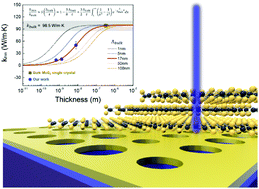Thickness-dependent in-plane thermal conductivity of suspended MoS2 grown by chemical vapor deposition†
Abstract
The in-plane thermal conductivities of suspended monolayer, bilayer, and multilayer MoS2 films were measured in vacuum by using non-invasive Raman spectroscopy. The samples were prepared by chemical vapor deposition (CVD) and transferred onto preformed cavities on a Au-coated SiO2/Si substrate. The measured thermal conductivity (13.3 ± 1.4 W m−1 K−1) of the suspended monolayer MoS2 was below the previously reported value of 34.5 ± 4 W m−1 K−1. We demonstrate that this discrepancy arises from the experimental conditions that differ from vacuum conditions and small absorbance. The measured in-plane thermal conductivity of the suspended MoS2 films increased in proportion to the number of layers, reaching 43.4 ± 9.1 W m−1 K−1 for the multilayer MoS2, which explicitly follows the Fuchs–Sondheimer suppression function. The increase in the thermal conductivity with the number of MoS2 layers is explained by the reduced phonon boundary scattering. We also observe that the Fuchs–Sondheimer model works for the thickness-dependent thermal conductivity of MoS2 down to 10 nm in thickness at room temperature, yielding a phonon mean free path of 17 nm for bulk.



 Please wait while we load your content...
Please wait while we load your content...